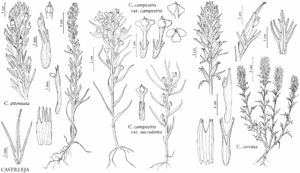Difference between revisions of "Castilleja attenuata"
Syst. Bot. 16: 656. 1991.
FNA>Volume Importer |
imported>Volume Importer |
||
| (3 intermediate revisions by 2 users not shown) | |||
| Line 10: | Line 10: | ||
|special_status={{Treatment/ID/Special_status | |special_status={{Treatment/ID/Special_status | ||
|code=F | |code=F | ||
| − | |label= | + | |label=Illustrated |
}} | }} | ||
|basionyms={{Treatment/ID/Basionym | |basionyms={{Treatment/ID/Basionym | ||
|name=Orthocarpus attenuatus | |name=Orthocarpus attenuatus | ||
| − | |authority=A. Gray in War Department [U.S.] | + | |authority=A. Gray |
| − | + | |rank=species | |
| + | |publication_title=in War Department [U.S.], Pacif. Railr. Rep. | ||
|publication_place=4(5): 121. 1857 | |publication_place=4(5): 121. 1857 | ||
}} | }} | ||
| Line 42: | Line 43: | ||
-->{{#Taxon: | -->{{#Taxon: | ||
name=Castilleja attenuata | name=Castilleja attenuata | ||
| − | |||
|authority=(A. Gray) T. I. Chuang & Heckard | |authority=(A. Gray) T. I. Chuang & Heckard | ||
|rank=species | |rank=species | ||
| Line 56: | Line 56: | ||
|publication title=Syst. Bot. | |publication title=Syst. Bot. | ||
|publication year=1991 | |publication year=1991 | ||
| − | |special status= | + | |special status=Illustrated |
| − | |source xml=https:// | + | |source xml=https://bitbucket.org/aafc-mbb/fna-data-curation/src/2e0870ddd59836b60bcf96646a41e87ea5a5943a/coarse_grained_fna_xml/V17/V17_1033.xml |
|genus=Castilleja | |genus=Castilleja | ||
|species=Castilleja attenuata | |species=Castilleja attenuata | ||
Latest revision as of 19:24, 5 November 2020
Herbs, annual, 1–4.5 dm; with fibrous roots. Stems solitary, erect to ascending, unbranched, sometimes branched from base, hairs spreading, short and medium, ± stiff, eglandular. Leaves green to purple-tinged, linear to linear-lanceolate, (1–)2–8 cm, not fleshy, margins plane, flat, 0(–5)-lobed, apex acuminate; lobes spreading to ascending, filiform to lanceolate, apex sometimes acuminate. Inflorescences (1.5–)2–10(–19, –30 in fruit) × 1–2 cm; bracts proximally green to pale brown, rarely dull reddish brown, distally white on apices, sometimes pale yellow or pale pink-purplish on apices, rarely greenish or dull reddish brown throughout, lanceolate or lanceolate-elliptic, 3(–5)-lobed; lobes ascending, linear to lanceolate, long, arising below mid length, apex acuminate, acute, or obtuse. Calyces colored as bracts, (8–)15–23 mm; abaxial and adaxial clefts (4–)6–8 mm, abaxial ca. 50% of calyx length, adaxial ca. 75% of calyx length, lateral 3–3.5 mm, 33% of calyx length; lobes linear to narrowly triangular, apex acute to acuminate. Corollas straight, 10–25 mm; tube 9–20 mm, not expanded distally; beak exserted, straight, adaxially white, light yellow, or greenish, 3–5 mm, inconspicuously puberulent; abaxial lip white or yellow with deep brown to purple spots, often becoming pink, slightly inflated, exserted or not, pouches 3, 2 mm wide, 1–1.5 mm deep, 3–4 mm, 75–80% as long as beak; teeth erect, white, pale yellow, or pink, 0.5–1.2 mm. Filaments glabrous. 2n = 24.
Phenology: Flowering (Feb–)Mar–Jun.
Habitat: Grasslands, pastures, moist margins of springs and streams, damp rocky slopes.
Elevation: 0–2100 m.
Distribution
B.C., Ariz., Calif., Oreg., Wash., Mexico (Baja California), South America (Chile).
Discussion
Castilleja attenuata is a common and widespread species, ranging from southwestern Canada to northern Baja California, with several disjunct populations in central Chile. It is sensitive to competition from weeds. Disjunct populations in the Rincon Mountains in Pima County, Arizona, often have pink bracts but are otherwise typical.
Selected References
None.
